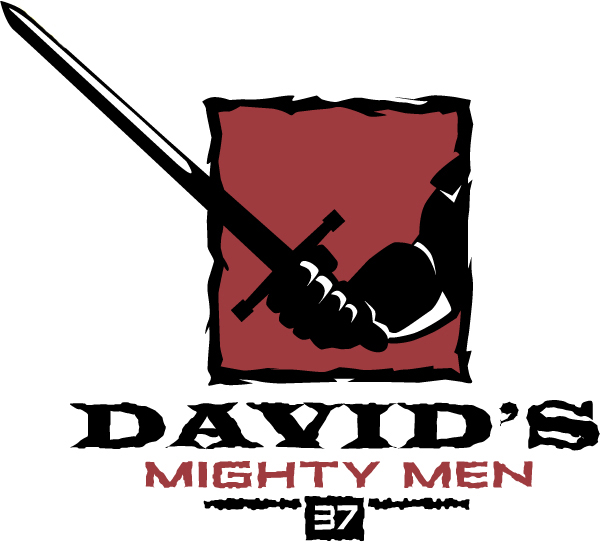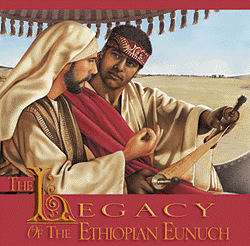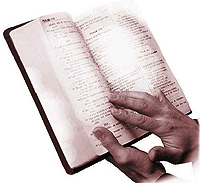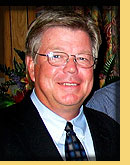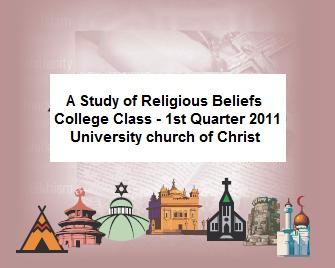Home | About Us | Directions | Bulletins | Sermons & Audio | Cross Of Christ Studies | Classes | Student and Parent Resource Page | Dangers Facing the "Non-Traditional"
The Restoration of First-Century Christianity
by Wayne Jackson
When Martin Luther visited Rome in the fall of 1510, he was appalled by the spiritual laxity he observed—even in the priesthood. His dissatisfaction with the Catholic Church would eventually lead to his challenge of that system, which was culminated when he nailed his Ninety-five Theses to the door of the cathedral in Wittenberg, Germany on October 31, 1517. But Luther simply wanted to reform the church of his day; he had no vision of leaving it.
Professor Harold O. J. Brown has written:
Although it was not Luther’s intention to found a new church, but simply to purify the old one, from the time of the Reformation there were new churches—first the Lutheran, then the Reformed, and finally the Anglican. From its beginning, the Reformation created new churches as no other movement had succeeded in doing (1998, 311).
The church of the Middle Ages, however, was far too corrupt to yield to any “band-aid” reformatory process. Though men like Luther, Calvin, Wesley, and others were perhaps moved by noble motives, they erred by thinking they bettered religious conditions by establishing new religious movements. These movements carried much of Rome’s theological baggage.
Happily, however, by-and-by men would arise—both in Europe and in America—who would grasp the concept of restoring Christianity to its primitive status, free from the stifling encumbrances of sectarianism. The ideal was to start afresh. Honest souls, in humble fashion, would embrace nothing but the pure gospel of Christ, unveneered by human tradition, and follow the New Testament as their only rule of faith and practice. What a breathtaking concept it was—indeed still is at this very hour!
The “Restoration” Ideal
There are two basic attitudes regarding the Christian religion.
(1) One disposition affirms that Jehovah, across several millennia of history, meticulously prepared for the initial advent of Christ and the spiritual system—Christianity—that he would inaugurate. This ideology argues that the divine format of the Christian system—as such existed in the first century under the guidance of inspired teachers—was exactly what God intended it to be.
Moreover, this view asserts that this sacred plan, as designed by the eternal and omniscient Creator, would be perpetually relevant, thus age-lasting (cf. Daniel 2:44). Those who advocate this concept maintain that if the world is ever to be saved, it must conform to the mold of primitive Christianity—and that the reverse should never prevail (cf. Romans 12:2).
(2) On the other hand, there is the adverse theory which alleges that the Christian religion was not designed to be static. Proponents of this credo argue that aside from a few “core” components (e.g., the fact that Jesus is the Son of God and that he died for the sins of humanity), the advocates of “Christianity” are free to alter its forms and rites, fashioning them anew as cultural peculiarities fluctuate. Supposedly, the Christian movement is free to experience an “evolutionary” development. It is thus suggested that the “Christianity” of today may be vastly different from that of the first century—yet still enjoy Heaven’s approval.
Which of these concepts is valid?
Anyone with more than a smattering knowledge of Scripture should know that the first view is the correct one. And yet, amazingly, the second proposition is being advocated by an increasing number of people—even a growing number within the church of the Lord.
It is not at all surprising that society finds the “new Christianity” appealing. We have been brainwashed to believe that anything new is also improved. The marketplace is flooded with “new and improved” products. And so, many reason, why doesn’t the same principle apply in religion?
The world of sectarianism has long operated on the premise that Christianity may “change” as circumstances demand. Catholicism employed this rationale as the basis upon which it adopted many pagan practices (e.g., the use of the Rosary and the worship of the Virgin Mary) in order to attract heathen converts (Mosheim 1959, 105). Allegedly, this made the pagan feel more comfortable in his new “Christian” environment. The Roman Church makes no apology for the fact that she can modify her doctrine as the times or culture changes. Many can remember when it was considered sinful for Catholics to eat meat on Friday. Today, it is not even a matter of conversational interest among many.
The Protestant sects, in actual practice, subscribe to a similar “evolutionary” approach to Christianity. For example, a popular creed book states:
It is most likely that in the Apostolic age when there was but “one Lord, one faith, and one baptism,” and no differing denominations existed, the baptism of a convert by that very act constituted him a member of the church, and at once endowed him with all the rights and privileges of full membership. In that sense, “baptism was the door into the church.” Now, it is different (Hiscox 1890, 22; emphasis added).
Why is it different? Who made it so? Certainly not God. Rather, arrogant men have assumed they have the right and the wisdom to renovate the divine scheme of redemption. The very attitude is an atrocity.
Not only has mainstream denominationalism contended that it is permissible to change the original forms and ceremonies of New Testament doctrine, it has even radically altered its concept of morality. Several decades ago there could not be found a solitary religious body, remotely professing Christian principles, that would endorse homosexuality. Now, the defenders of sodomy are disgustingly numerous.
If Christianity may be re-designed with reference to its religious dogma, why not re-write its moral code as well? The very idea is absurd.
Problems within Churches of Christ
The brotherhood of churches of Christ has become sorely afflicted with the “change” mentality over the past several decades. More than a third of a century ago, Carl Ketcherside and Leroy Garrett were creating a stir in many Christian congregations with radical notions of ecumenism, as advocated in their journals, Mission Messenger and Restoration Review. At that time, however, these gentlemen were considered to be a fringe-element aberration. Eventually, though, along came Integrity, Image (now defunct), and finally, Wineskins. These journals, in concert with several “Christian Scholars Conferences” on campuses like Abilene Christian University and Pepperdine University, flung the doors wide open to radical changes within the fellowship of God’s people.
The drift has been gradual. At first, the concept of the “restoration plea” was merely questioned—under the guise of honest investigation. Then it was overtly challenged. Finally, in the waning days of this century, it is shamelessly ridiculed by those who have thrown off all attempts to disguise their ambitions. Some of our digressive brothers take unusual delight in mocking the church, while their sectarian audiences roar with laughter and applaude the barbs that wound the body of Christ.
Rubel Shelly, of Nashville, Tennessee has been one of the most vociferous critics of the restoration movement in recent years. His speeches at the Christ Church Pentecostal denomination in Nashville (April 13, 1994), at the 1995 Tulsa Workshop, and at the Florence (Alabama) Spiritual Renewal Conference (April 19, 1996) are but a sampling of this misguided brother’s hostile mood. (Note: For further discussion see Jackson 1991, 40-44.)
The Biblical Platform
The fact is, the Bible teaches that when the Creator establishes a system of religion, its obligations are to remain intact until God himself provides evidence that it no longer is operative. No one is to presume to modify the divine arrangement. The Old Testament emphasizes this principle repeatedly.
Surely no clearer example of this concept can be found than that of the sad case of Jeroboam I, the premier king of northern Israel. His apostasy from the Mosaic pattern is carefully documented in 1 Kings 13. Note the following:
1.He changed the object of worship from the invisible God to golden calves, which were to represent the Lord.
2.The monarch switched the sacred center of devotion from Jerusalem to Bethel and Dan.
3.Priests could be selected from tribes other than Levi.
4.A new feast was inaugurated to rival the feast of the tabernacles.
Modern “Jeroboams” doubtless would endorse these alterations as quite refreshing; after all, we can’t be stifled by “traditionalism.” Jehovah’s attitude, however, was radically different. In approximately twenty-one passages the Old Testament refers to Jeroboam, the son of Nebat, who “made Israel to sin” (cf. 1 Kings 14:16). Innovation is transgression!
“Restoration” Defined
When one speaks of a “restoration” plea, several things are implied. First, there is the suggestion that there is a divine pattern for human conduct. Second, God expects conformity to that pattern. Third, in the nature of things, rebellious and frail men will digress from that heavenly way. Fourth, it is the responsibility of those who revere the Lord’s will to restore the primitive order and call their fellows back to the “old paths” (cf. Jeremiah 6:16).
There are numerous New Testament passages which stress these truths. Let us consider a few:
1.The early church is clearly a model for us in that it “continued steadfastly in the apostles’ teaching” (Acts 2:42). Why was that an important point for Luke to make if the pattern of the “apostles’ teaching” is irrelevant? Moreover, the multitude of believers “were of one heart and soul” (4:32), suggesting a unity of practice in their Christian decorum.
2.Paul reminded the saints in Rome that they had been made free from sin due to the fact that they had been obedient to a certain “form” (pattern) of teaching (Romans 6:17, 18). Can such a passage yield any sense if there is no pattern?
3.The Christians in Rome were admonished to “mark” (be on the lookout for) and turn away from those who were causing divisions “contrary to the teaching” which they had learned (Romans 16:17). If there is no pattern of New Testament doctrine, how could one ever be required to “turn away” from those who do not conform to it?
4.The inspired Paul instructed the brethren in Corinth not to go “beyond the things which are written” (1 Corinthians 4:6 ASV). This clearly demonstrates that spiritual activity is regulated by the Scriptures.
5.The primitive Christians were warned repeatedly about “falling away” from “the faith” (cf. 2 Thessalonians 2:3; 1 Timothy 4:1ff; 2 Timothy 4:1ff). The expression “the faith” has to do with a body of doctrinal truth. If there is no doctrinal pattern, how could one ever “fall away” from the faith? Note also that identifying marks of apostasy went beyond so-called “core” matters, such as the deity of Christ. They concerned things like the forbidding of marriage and prohibiting of certain foods (1 Timothy 4:1ff).
6.Paul spoke of the “pattern of sound words” (2 Timothy 1:13) which the early Christians were being taught and in which they were to “abide” (3:14). These truths were to be passed on to others (2:2), and men were to be charged not to teach a “different doctrine” (1 Timothy 1:3). How in the name of common sense can men read these passages and not know that there is a body of sacred truth with which we must not tamper?
7.The writer of Hebrews affirmed that Moses, in constructing the tabernacle, was warned by God that he must “make all things according to the pattern,” which was shown to him at Horeb (8:5). Do we, as recipients of the “better covenant” (Hebrews 7:22; 8:6), sustain a lesser responsibility as we minister to God in his church—of which the tabernacle was but an inferior type? (cf. 9:1-10). It is unbelievable that anyone would dare to argue such.
8.John unequivocally states that those who go beyond the “teaching of Christ” have no fellowship with God (2 John 9).
Conclusion
All of these passages—and numerous others—forcefully reveal that there is a divine standard to which men are accountable. The grass withers and the flowers fade, but the word of God, with its inscribed obligations, abides (cf. 1 Peter 1:24-25).
In physics there is a law known as the Second Law of Thermodynamics. It suggests that things proceed toward a state of degeneration. It might also be argued that there is sort of a Second Law in the spiritual realm as well. Men tend to drift; the pure frequently becomes contaminated. Such was never more clearly indicated than in the current status of the church of God.
This is not the time to relax the call for a restoration to the ancient order of Christianity. We are truly at the crossroads!
Sources/Footnotes Attwater, Donald, ed. 1961. A Catholic Dictionary. New York, NY: The Macmillan Co. Pg. 363.
Brown, Harold O. J. 1998. Heresies. Peabody, MA: Hendrickson.
Hiscox, Edward T. 1890. The Standard Manual For Baptist Churches. Philadelphia, PA: The American Baptist Publication Society.
Jackson, Wayne. 1991. Contemporary Attacks on the Restoration Principle. The Spiritual Sword, Vol. 23, No. 1.
Mosheim, John Lawrence. 1959. Ecclesiastical History. Vol. 1. Rosemead, CA: Old Paths Book Club.
Other Articles by Wayne Jackson
Baby Dedication Ceremonies: Expedient or Innovation?
Did the Early Church Observe the Lord's Supper Daily?
The New Testament Pattern of Giving
Aid or Addition - What is the Difference?
